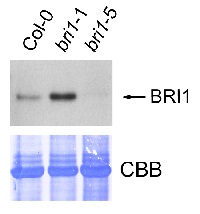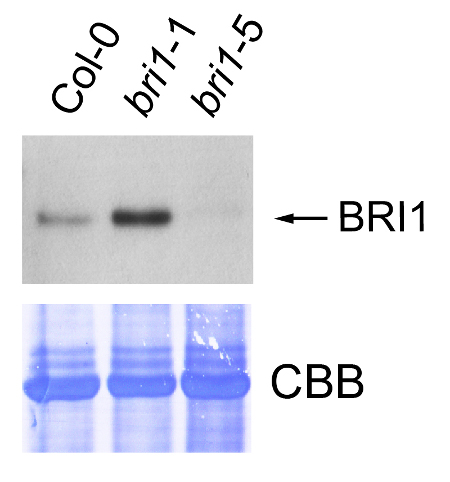1

Anti-BRI1 | Brassinosteroid insensitive 1
AS12 1859 | Clonality: Polyclonal | Host: Rabbit | Reactivity: Arabidopsis thaliana
- Product Info
-
Immunogen: KLH-conjugated synthetic peptide derived from Arabidopsis thaliana BRI1 protein, Uniprot: O22476, TAIR: AT4G39400 Host: Rabbit Clonality: Polyclonal Purity: Immunogen affinity purified serum in PBS pH 7.4. Format: Lyophilized Quantity: 50 µg Reconstitution: For reconstitution add 50 µl of sterile water Storage: Store lyophilized/reconstituted at -20°C; once reconstituted make aliquots to avoid repeated freeze-thaw cycles,Please remember to spin the tubes briefly prior to opening them to avoid any losses that might occur from material adhering to the cap or sides of the tube. Tested applications: Immunoprecipitation (IP), Western blot (WB) Recommended dilution: 1 : 5000 (WB) Expected | apparent MW: above 130 kDa (due to N-glycosylation)
- Reactivity
-
Confirmed reactivity: Arabidopsis thaliana Predicted reactivity: Brassica napus, Brassica rapa
Species of your interest not listed? Contact usNot reactive in: Hordeum vulgare, Oryza sativa, Solanum lycopersicum
- Application Examples
-

15 µg of total protein from leaf material of 5 week-old plants of Arabidopsis thaliana, were extracted with homogenization buffer (250 mM sucrose, 50 mM HEPES-KOH pH 7.5, 5% glycerol, 0.5% Triton X-100, 50 mM Na4P2O7, 1 mM Na2MoO4, 25 mM NaF, 2 mM DTT, Sigma plant protease inhibitor cocktail). 3 parts of protein extract were mixed with 1 part of standard SDS loading buffer (200 mM TRIS pH=6.8, 400 mM DTT, 8% SDS, 40% glycerol, 0.1% bromophenol blue). Protein denaturation was done at 90°C/5 min. Proteins were separated on a 10 % SDS-PAGE and blotted using BioRad Tank Blot device onto a PVDF membrane at 100 V for 1 h 15 using following blotting buffer: 50 mM TRIS-base, 50 mM boric acid of pH of 8.3. Blots were blocked with TBS-T (150mM NaCl, 10mM Tris-HCl pH8, 0.05% Tween-20) containing 5% skimmed milk powder for 1h at room temperature (RT) with agitation. The blot was incubated in the primary antibody at a dilution of 1: 5 000 in TBS-T with milk powder overnight at 4°C with agitation. The antibody solution was decanted and the blot was rinsed briefly twice, then washed 5 times for 15 min in TBS-T (with milk powder) at RT with agitation. The blot was then incubated in secondary antibody (Agrisera Goat anti-rabbit IgG (H&L) HRP conjugate, AS09 602) diluted to 1:5000 in TBS-T (with milk powder) for 2h at RT with agitation. The blot was washed 5 times for 15 min in TBS-T (without milk powder) and developed using chemiluminescent detection. Exposure time was 3 minutes.
Courtesy of Dr. Elena Petusching, Georg-August-University Goettingen, Germany
Application examples: 
Reactant: Arabidopsis thaliana (Thale cress)
Application: Western Blotting
Pudmed ID: 31519953
Journal: Nat Commun
Figure Number: 7A,B
Published Date: 2019-09-13
First Author: Chen, W., Lv, M., et al.
Impact Factor: 13.783
Open PublicationBES1 can be activated by the EMS1-TPD1-SERK1/2 signaling pathway. a Immunoblotting analyses using transgenic plants harboring pBRI1::TPD1(TPD1), pBRI1::EMS1-GFP(EMS1), or both in Col-0 indicated that the expression of TPD1 and EMS1 can lead to the accumulation of non-phosphorylated BES1. b The TPD1- and EMS1-induced accumulation of non-phosphorylated BES1 is independent of the BR signaling. Homemade anti-BES1 antibody was used to detect phosphorylated (p-BES1) or non-phosphorylated BES1 (BES1). bes1-c1, bes1-c2 bzr1-c1 were used as negative controls for the anti-BES1 antibody. Coomassie Brilliant Blue stained rubisco protein was used as a loading control. EMS1-GFP and BRI1 immunoblotting analyses were carried out by using anti-GFP or anti-BRI1 antibody to confirm the accumulation of EMS1-GFP and the bri1-116 background, respectively. c, d Nuclear localization of BES1 or BZR1 in the somatic cell layer closest to the microsporocytes is partially dependent on the presence of EMS1. Scale bars represent 20??m
- Additional Information
-
Additional information: This product can be sold containing proclin if requested Additional information (application): Antibody was tested on bri1-1 and bri1-5 mutants. Bri1-1 is a point mutation in the kinase domain that renders the protein non-functional and plants compensate for that by over-accumulating the non-functional receptor. Bri1-5 is a mutant in the extracellular domain and the bri1-5 protein is retained in the ER. The bri1-5 plants contain less protein than the wild type and show an intermediate brassinosteroid deficient phenotype. Also BRI1-5 migrates higher than wild type BRI1 in SDS-PAGE, because it carries ER-type high mannose N-glycans.
For IP: 15 µl GFP-trap beads was used for 200 mg plant material to precipitate GFP-tagged protein followed by detection with Co-IPed BRI1 on Western with 1:5000 diluted anti-BRI1 antibody.
Protein extraction has to be done efficiently as this step is crucial, recommended material to buffer ratio: 15 µl/µg or less. - Background
-
Background: BRI1 (Protein BRASSINOSTEROID INSENSITIVE 1) is a receptor which binds brassinolide and has a dual specificity kinase activity acting on both serine/threonine- and tyrosine-containing substrates. Involved in a signaling cascade including expression of light- and stress-regulated genes, promotion of cell elongation, normal leaf and chloroplast senescence, and flowering. Alternative names:BRI1, BRASSINOSTEROID INSENSITIVE 1, CBB2, CABBAGE 2, DWF2, DWARF 2, BIN1, BR INSENSITIVE 1, ATBRI1, Brassinosteroid LRR receptor kinase - Product Citations
-
Selected references: Takagi et al. (2025). Plant-specific tail-anchored coiled-coil protein MAG3 stabilizes Golgi-associated ERESs to facilitate protein exit from the ER. Commun Biol. 2025 Mar 4;8(1):358.doi: 10.1038/s42003-025-07602-1.
Kamińska et al. (2024). Comprehensive elucidation of the differential physiological kale response to cytokinins under in vitro conditions. BMC Plant Biol. 2024 Jul 15;24(1):674.doi: 10.1186/s12870-024-05396-8.
Jing et al. (2024). Copine proteins are required for brassinosteroid signaling in maize and Arabidopsis. Nat Commun. 2024 Mar 8;15(1):2028.doi: 10.1038/s41467-024-46289-6.
Ormancey et al. (2023) Complementary peptides represent a credible alternative to agrochemicals by activating translation of targeted proteins. Nat Commun. 2023;14(1):254. Published 2023 Jan 17. doi:10.1038/s41467-023-35951-0.
Luo, Takagi, Claus LAN, et al. (2023) Deubiquitinating enzymes UBP12 and UBP13 stabilize the brassinosteroid receptor BRI1. EMBO Rep. 2022;23(4):e53354. doi:10.15252/embr.202153354
Lee et al (2021). Chaperone-like protein DAY plays critical roles in photomorphogenesis. Nat Commun. 2021 Jul 7;12(1):4194. doi: 10.1038/s41467-021-24446-5. PMID: 34234144; PMCID: PMC8263706.
Chen et al. (2019). BES1 is activated by EMS1-TPD1-SERK1/2-mediated signaling to control tapetum development in Arabidopsis thaliana. Nat Commun. 2019 Sep 13;10(1):4164. doi: 10.1038/s41467-019-12118-4.
Hou et al. (2019). Less Conserved LRRs Is Important for BRI1 Folding. Front Plant Sci. 2019 May 21;10:634. doi: 10.3389/fpls.2019.00634. eCollection 2019.
Chen et al. (2019). BZR1 Family Transcription Factors Function Redundantly and Indispensably in BR Signaling but Exhibit BRI1-Independent Function in Regulating Anther Development in Arabidopsis. Mol Plant. 2019 Jun 20. pii: S1674-2052(19)30207-2. doi: 10.1016/j.molp.2019.06.006. - Protocols
-
Agrisera Western Blot protocol and video tutorials
Protocols to work with plant and algal protein extracts
Agrisera Educational Posters Collection
- Reviews:
-
This product doesn't have any reviews.



